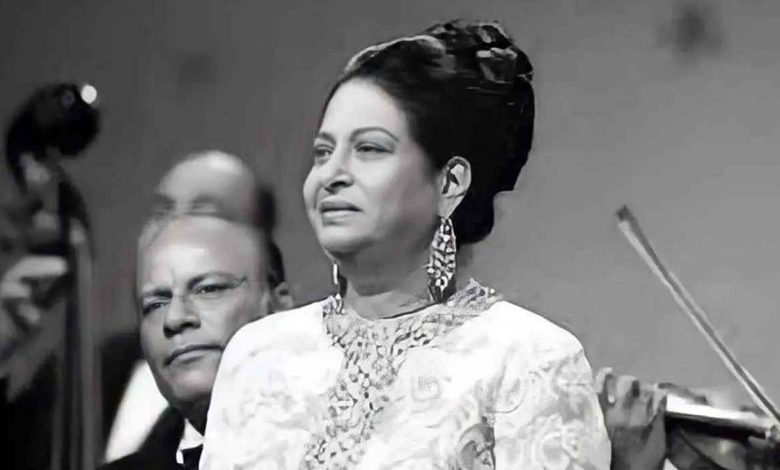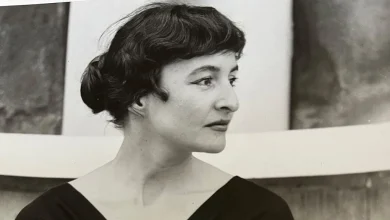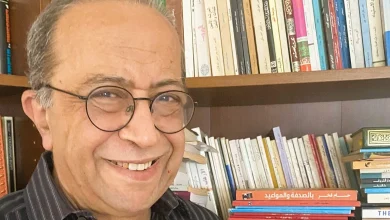
No human voice dominated, and still dominates Cairo’s spaces, like Om Kalthoum’s voice. It has become a feature known to everyone who frequents the Egyptian capital and a main feature of the place. It was welded into the city’s details becoming an expression of and from it. This is how “Al Set” (The lady) – who passed away fifty years ago- has imposed her rhythm on Cairo.
In her moments of glory she drew pathways in the city and with a gesture from her famous handkerchief she imposed silence on a city that thrives on rowdiness.
Humans and stone come together in one sculpture that lends itself to receiving the whiffs of the explosive talent. A voice the heavens generously bestowed once and Cairo received it well and sanctified it as an exemplar of the 1000 year old city. The latter lacked a voice that can express its vast history and then found it in the miracle that is Om Kalthoum. It found no better representation of it than her voice and “Al Set’s” unpartnered raise to the throne of Arab singing was nothing if not a transformation in the identity of Cairo that was passing through a historical juncture. Om Kalthoum excellently expressed some features of this juncture throughout her artistic journey.
***
Cairo was subjected to quick and violent transformations throughout the 20th century starting with the process of modernization that took place to the tempo of clashes between Egyptian freedom seekers and the British occupation. It ran from the explosive feelings of nationalism born with the 1919 revolution to the cosmopolitan city and its intermingled and decussate worlds of foreigners, effendis and locals. Later came the era of the social and economic crisis and the political dead end that characterized the 1940s and from there onto the July revolution and the birth of Gamal Abdel Nasser’s leadership and nationalist social project. Following that came the years of war, victory and defeat followed by the eras of Sadat and Mubarak and the violent political, economic and social changes. During all of this the towering wall in the city’s structure was Om Kalthoum’s voice. It resonated since its birth in all corners of the city that witnessed moments of glory, sadness, gloom, joy, distraction and decline.
Om Kalthoum left behind what could be considered a memoir about her early period in Cairo. This material is fit to be used to explore her view of the city and how she noted the details of the third decade of the 20th century in a parallel to analyzing the role that the mistress of Arab singing has played in forming the Cairene society as she was influential among the city’s elite society. On the other hand she was also influential, through her voice among all classes and strata of the Cairene society. It is a matter that enables us to shed light on the interaction between the source of this miraculous voice and Cairo as a vessel that turned into the main theatre on which the movement of the exceptional talent is witnessed. This may help us in exploring some sides of Om Kalthoum’s exceptional greatness and her transformation into the voice of the city after her multifaceted influence on different social and artistic aspects of life in Cairo.
***
Om Kalthoum arrived in Cairo at the beginning of the 1920s, a peasant girl from the depth of the delta. “I discovered that there is a new city called Cairo! I discovered it by pure coincidence”. This is what the great writer Mahmoud Awad says about her in the book “Om Kalthoum Whom No One Knows” which he based on interviews with her; that is, it’s a book containing memoirs that she dictated to him and a biography about her written in the eloquent pen of Awad.
This first meeting for the child who is flying freely into the world of religious music along with her brother and father was faded as far as she remembers. This visit that seems to have taken place in the third decade of the 20th century did not imprint itself on her memory with a few exceptional scenes. In the following visit her life savings were lost when she sang in AlAtaba Al Khadra. This cruel experience had her promising herself not to visit the capital again. But the call of the capital was stronger than the loss of all the riches of the world, says Om Kalthoum, who we could have all lost because of a pickpocketing incident!
Om Kalthoum fell in love with Cairo on her second visit when she stayed at the Gordon House Hotel overlooking Fouad St. (now 26th of July Street). She saw a film theater for the first time from the balcony of her room. She saw a “strange world” and in this room “Shiekh Aboul Ela” heard her and decided to supervise her explosive talent. In the early twenties of the previous century Om Kalthoum settled in Cairo and specifically in Zamalek. She knew very little of the city at the time.
***
She kept her first impression of the city throughout the first four years she spent in it. She says “Cairo to me was the way from Zamalek to Bab El Khalq (where here friend Rawheya, the daughter of the Oud player Ameen Al Mahdy lived).. The capital to me was Fouad Street, Kasr El Nil Square, Abdeen Square and Bab El Khalq Square.. My knowledge of Cairo was what I read about it in newspapers and magazines and what I heard from people. Despite the siege I lived in, I loved Cairo greatly. I felt I lived in the most beautiful city in the world. I loved its people and found in this beautiful city safety, care and encouragement. I found in it, a glory that would have not crossed anyone’s mind”. These feelings were Om Kalthoum’s motivation to defend her decision to stay in Cairo when her father wanted to leave the city and return to Tamay El Zahaira, after a malicious attack on his daughter in a newspaper in 1926. She mobilized the family’s acquaintances to convince him to change his mind, and she got what she wanted.
***
When Om Kalthoum came to Cairo the city was passing through consecutive changes. The country was still processing the consequences of the Egyptian revolution, the nominal independence, the birth of the kingdom and the raising status of Saad Zaghloul as a leader along with his Wafd Party. A new life was running through the streams of Egyptian social reality that was witnessing for the first time a clear formation of the concept of Egyptian Nationalism. The young generation of effendis had started looking for means to express the Egyptian nation’s merit for complete independence through asserting the ability of Egyptians to run their own affairs and to stand on an equal civilized footing with developed nations without the need for British protection. A wave of Egyptianization started everywhere. In economy, politics, art, culture, singing, theatre, literature ect..
Om Kalthoum’s very Egyptian voice, vibrant with an exceptional talent, appeared in this atmosphere. It is important here to point out that the success story of Om Kalthoum as a girl from the country side who carved her own path because of her talent is identical to the stories of the raise of the generation of Effendis who controlled the cultural and intellectual life in the 20s and 30s and beyond. They saw in her a feminine expression of their journey and their spirit that represent the pure Egyptian spirit in light of her presenting art free from depravity and in a context of prudence and seriousness. The Egyptian image that they wanted to present to counter the image they did not accept represented by the female singers of her era, foremost among whom was Mounira Al Mahdia.
Om Kalthoum got to know Cairo’s spirit and learnt how to control its tempo. This time the city fell in love with the exceptional singer and opened the doors of its theaters to receive the girl whose voice echoed in the place. She mastered the rules of the game and knew how to blend into the urban society without losing her self-respect. She gave up her traditional family based band and formed a professional band of the masters of music at the time. She sang in Emad El Din Street theaters. At the crossing of that street with Fouad street once stood a theater that she had rented and that was named after her.
***
She sang in the Café Riche garden and entered into film and sang in the Egyptian opera in Azbakeya. She was no longer a stranger to the place especially since she blended into the Cairo elite and became a star of social circles. She left her headscarf, coat and Bedouin appearance that she donned when she first started and exchanged it to a more solemn appearance of a demure Cairene girl. Elegant but reserved. She received the support of famous Cairene personalities foremost among which was Shiekh Mostafa Abdel Razek who later headed Al Azhar and who wrote an article supporting her and later championed and backed her a lot.
We are able to draw a map of Om Kalthoum’s movements around Cairo. She sang in Al Ahly club; in front of the Cinema Kasr El Nil theatre we may allow our imagination to wonder in the place where she held many concerts. She moved between her house in Fouad Street in Zamalek to a villa overlooking the Nile in the same neighborhood. Here the earthly miracle lived to the end of her life. The old structure no longer stands. In the latter years of the open door policy it was replaced with a meaningless ugly building. As an afterthought a statue of herself was erected in front of it. She is the only woman who is represented in two statues in Cairo. The second is inside the opera house in the southern tip of the Zamalek island, as if the island is dedicated for her.
***
We follow the theatres on which she sang in Emad El Din Street and Azbakeya, enriching our virtual map of her travels in the city. More importantly she imposed deep mental images on many levels. Her presence formed the most important support for women’s issues at the time. Women were no longer commodities. She elevated Egyptian art and rid it of debaucherous singing that stuck like an accusation to female singers. She achieved a class based victory for the peasant girl that conquered Cairo’s elite society and its aristocracy until her influence reached the gates of the royal palace and then the revolutionary command council.
After her contract with the Egyptian radio at the end of the 1930s in which it was agreed that the radio will broadcast her concert on the first Thursday of every month, Om Kalthoum became officially the voice of Cairo. Her concerts contributed to the shaping of Cairenes’ social life as meetings were postponed and appointments cancelled so that everyone can stay home by the radio. Virginia Danielson, author of Om Kalthoum’s biography (The Voice of Egypt”: Umm Kulthum, Arabic Song, and Egyptian Society in the Twentieth Century) noted that the first Thursday of every month became, to most Egyptians, the “Om Kalthoum night”. This solidified her legendary status. “Her concerts became occasions in which people were invited to gather around the nearest radio to listen to what she is going to sing on Thursday night as entertainment among friends and relatives… The concerts on the the first Thursday of the month remained major events in popular Egyptian culture until they were stopped due to her illness and subsequent death”
***
Some may argue that the scene of her funeral is the scene of her complete hegemony over the space of the city as she is the only woman who was given such a legendary farewell mixed with the solemnity of death. A moment equal to the history of her concerts on the first Thursday of the month when she imposed her hegemony over the tempo of the city for decades, everyone listening to her. The hemogeny of four decades came full circle and it was remarkable that the photographs of her farewell that turned into a demonstration of valediction shows a majority of youth among the mourners. Among the pouring tears and sad faces, a raising future in which Om Kalthoum’s voice continued to be present and time only made it deeper and more rooted.
I thus see the final scene of Om Kalthoum’s homogeny over the city and her development into one of its uber symbols, that is her becoming one of the symbols that identify the place, is the scene of the new millennium in which her voice and picture are heard and seen everywhere. Cairo, in the popular imagination, has become Al Set’s City. She is the voice of Cairo and Egyptians in general. Dozens of cafés carry her name and her voice flows carrying joy with (Ya Sabah Al Khier Yalli Ma’na) “Good morning for those in attendance” and rings in the darkness of night with “You are my Life” (Enta Omri).
***
You hear her voice ringing with glee from a car rushing by, intruding onto your loneliness from a source unknown to you. That is how she became one of the city’s eternal symbols. We say the Cairo of Al Moez, of the Salah ElDin Citadel, of Mohamed Ali Mosque, the Gamaliya of Naguib Mahfouz and the voice of Om Kalthoum. Things that out live time and win its battle with it giving the place its definition and particularity. It turns into part of its mosaic of identification. This is how Om Kalthoum redefined the Cairo scene to become the voice of the place and its expression. Ironically the city victorious was conquered by her victorious voice.




